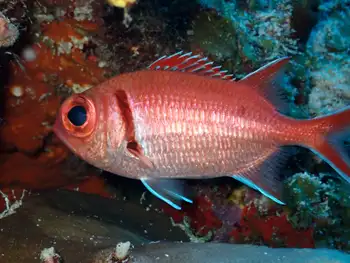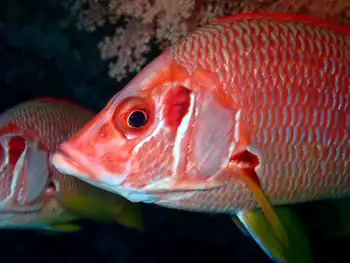Taxonomy
Animalia
Chordata
Actinopterygii
Beryciformes Holocentridae
Entire-spine Beryl-fish-shaped Ray-finned Chord-possessing Life-possessing-beings
The Beryciformes are a poorly-understood order of carnivorous ray-finned fishes consisting of 7 families, 30 genera, and 161 species. They feed on small fish and invertebrates. Beyond this, little is known about the biology of most member species because of their nocturnal habits and deepwater habitats. All beryciform species are marine and most live in tropical to temperate, deepwater environments. Most live on the continental shelf and continental slope, with some species being found as deep as 2,000 m (6,600 ft). Some species move closer to the surface at night, while others live entirely in shallow water and are nocturnal, hiding in rock crevices and caves during the day. Several species are mesopelagic and bathypelagic. Beryciformes' bodies are deep and mildly compressed, typically with large eyes that help them see in darker waters. Colors range from red to yellow and brown to black, and sizes range from 8–61 cm (3. 1–24. 0 in). Member genera include the alfonsinos, squirrelfishes, flashlight fishes, fangtooth fishes, spinyfins, pineconefishes, redfishes, roughies, and slimeheads. A number of member species are caught commercially, including the alfonsino, the splendid alfonsino, and the orange roughy, the latter being much more economically important. Some species have bioluminescent bacteria contained in pockets of skin or in light organs near the eyes, including the anomalopids and monocentrids.
Beryciformes. Retrieved May, 08 2021, from en.wikipedia.org/wiki/Beryciformes.
Holocentridae is a family of ray-finned fish, belonging to the order Beryciformes with the members of the subfamily Holocentrinae typically known as squirrelfish, while the members of Myripristinae typically are known as soldierfish. In Hawaii, they are known by the Japanese name mempachi/menpachi (メンパチ) or the Hawaiian ʻūʻū.
They are found in tropical parts of the Indian, Pacific and Atlantic Oceans, with the greatest species richness near reefs in the Indo-Pacific. Most are found at depths from the shoreline to 100 m (330 ft), but some, notably the members of the genus Ostichthys, are generally found far deeper. Being largely or entirely nocturnal, they have relatively large eyes. During the day, they typically remain hidden in crevices, caves, or under ledges. Red and silvery colours dominate. The preopercle spines (near the gill opening) of the members of the subfamily Holocentrinae are venomous, and can give painful wounds. Most have a maximum length of 15–35 cm (6–14 in), but Sargocentron iota barely reaches 8 cm (3 in), and S. spiniferum and Holocentrus adscensionis can reach more than 50 cm (19. 5 in). The squirrelfishes mainly feed on small fishes and benthic invertebrates, while the soldierfishes typically feed on zooplankton. The larvae are pelagic, unlike the adults, and can be found far out to sea.
Holocentridae. Retrieved May, 08 2021, from en.wikipedia.org/wiki/Holocentridae.


